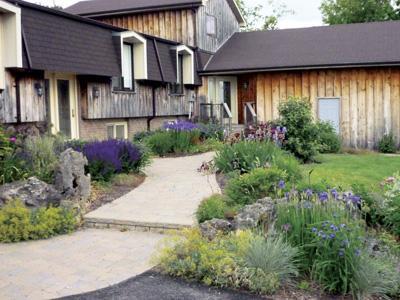March 25, 2013
To the last drop - Efficiency in landscape water usage
BY SEAN JAMESLast month we looked at what’s new and exciting in the irrigation industry and chatted with a couple of our industry’s leading eco-irrigation specialists. Landscape irrigation uses an enormous percentage of our processed water supply. Treating water costs money and resources. Water is a finite resource that we must use respectfully. For example we can use it so quickly that the water cycle collapses, leaving us with none, (Google what happened in the Aral Sea in Russia, if you need convincing.)
So how do we reduce landscape water needs? Whenever we talk about reducing irrigation, we should look at ways to landscape using less water. Xeriscaping is a drought-tolerant landscaping technique involving designing with plants that require little or no irrigation. Spot watering is another technique, but it involves more thought and input than most of today’s homeowners are willing to expend. Many landscapes designed primarily with prairie natives are inherently drought tolerant and also beautiful. There are native cacti and fascinating non-native plants such as catmint, sea kale and evergreen oat grass that add interest to the landscape while reducing water use.
Perhaps one day grey water use, harvesting water from sinks and laundry for use in the landscape, will be accepted by municipalities, resulting in a reduction of potable water use and less stress on our infrastructure — but not yet, in most places.

This xeriscape includes two invisible rain gardens, and looks beautiful all year, even in winter.
Not all landscaping can be drought-tolerant but it can all still have environmental benefits. While vegetable gardens are big water consumers, the benefits to the environment and to our own health offset the harm of their consumption.
Mulching helps retain moisture in the soil, as does incorporation of organic matter such as compost. These also have the benefits of increased nutrient availability, better mycorrhizal health, and increased infiltration and moderation of soil temperatures. Composted pine mulch is the best of both worlds, utilizing bark off-castings from the lumber industry and mixing it with compost to help improve the success of the landscape in many ways.
There are drought tolerant turf types such as perennial rye grass, and new varieties of rhizomatus tall fescue that reduce water use, repel insects and resist fungal attack. Look into these if turf is important in your customers’ landscapes. Over-seeding and topdressing is an excellent way to upgrade an existing lawn, since it requires minimal work and disturbance of the existing soil, yet allows improved varieties of seed to be incorporated into the lawn.
Rainwater harvesting for any irrigation other than spot watering is viable only in places that have regular rain throughout the growing season. Many places simply don’t get enough rain to keep the rain barrel full for irrigation all season. Rainwater harvesting is more about delaying storm water from immediately flowing into the sewer system than storage for irrigation purposes. They are not terribly good at communicating this to the public, but conservation authorities and municipalities rightly want us to use rain barrels to hold part of a rain event, so it can be released into the landscape between rainfalls, when the ground can absorb the water, instead of it flowing into the storm sewers. Rain gardens, bioretention cells, French wells and infiltration trenches are other excellent methods of infiltration. Modern development has created more impervious surfaces per square foot, which means more runoff to the storm sewers and less infiltration into the soil. This means more stress on our sewer systems and more damage and erosion to our creeks and rivers.
Often, when customers are asked whether or not they are interested in eco-friendly options, the answer is, no. This might be because they don’t know what’s available and are self-conscious about admitting it, or they are feeling overwhelmed with options. On the other hand, when options are presented as part of a design or quote, and those options are clearly and enthusiastically explained, many customers are quite happy to move forward with such ideas. They even seem happy to be ‘doing the right thing’. Sometimes it just needs an explanation that the costs can be recovered over a certain timeline or the option will be equally as beautiful, or even more so, than traditional methods. It’s always worth a try and the results can benefit us all.
Sean James is owner of an Ontario-based, environmentally-conscious landscape design/build/maintenance company. In addition, he is an eco-consultant and a popular speaker.